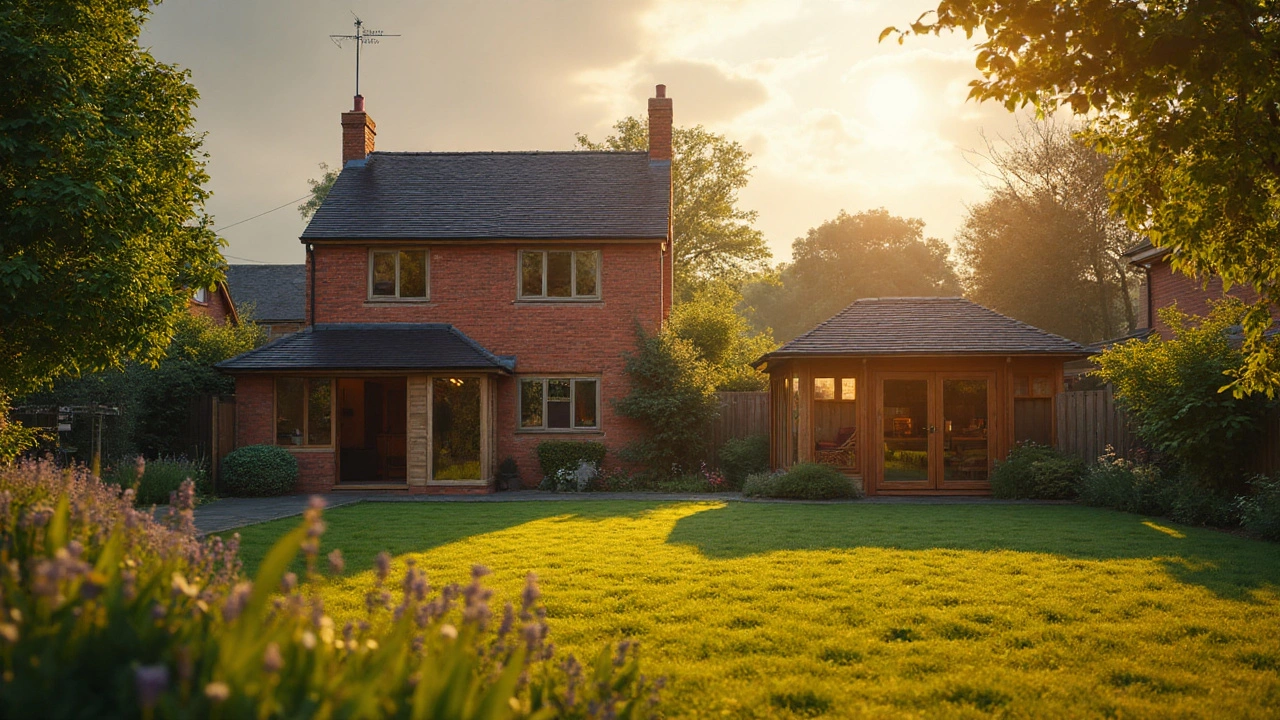Cheapest Ways to Extend a House in the UK (2025): Costs, Planning, and Money-Saving Tips
If you’re hunting for the cheapest way to extend a house, start with this simple idea: use what you already have before you build more. In 2025, the lowest-cost “extensions” are often conversions and small, smart add-ons-things that don’t drown you in planning fees, steelwork, or fancy glazing. I live in a Manchester terrace, typing this while my cat, Whiskers, eyes the tape measure. I’ve priced these jobs for friends and neighbours, and the same pattern keeps showing up-keep it simple, keep it local, and your wallet breathes easy.
TL;DR: Your Cheapest Extension Options (2025 UK)
- Garage conversion is usually the lowest-cost liveable space add: £12k-£25k for 14-18 m².
- Loft “rooflight-only” conversion: £25k-£40k for a bedroom/home office; dormer costs £40k-£70k.
- Single-storey lean-to rear extension with a simple roof and modest glazing: £1,800-£2,400/m² (North), £2,500-£3,500/m² (London/South East).
- Garden room (not connected to the house) can be cheap for an office: £8k-£25k, but not a “house extension” in valuation terms.
- Use Permitted Development to dodge full planning and speed things up, but you still need Building Regulations sign-off.
What “Cheapest” Really Means: Costs, Value, and UK Rules in 2025
Cheap isn’t just about the sticker price. Think cost per usable m², time to build, planning risk, and how well the new space actually solves your problem. If a £15k garage conversion replaces a £35k kitchen extension, that’s real savings. If you blow £6k on folding doors you open three times a year, you’ve paid for drama, not function.
Let’s pin down realistic numbers I’m seeing in the North West (Manchester and nearby) and from reliable industry baselines like RICS cost data and UK trade pricing in 2025:
- Garage conversion (integral/attached): £12k-£25k.
- Loft conversion: rooflight-only £25k-£40k; dormer £40k-£70k; hip-to-gable £55k-£90k.
- Single-storey rear extension (basic spec): North £1,800-£2,400/m²; London/South East £2,500-£3,500/m².
- Side-return infill: similar rates to single-storey rear, but steels/drain moves can push you up.
- Two-storey extension: lower cost per additional m² upstairs, but higher total: often £2,000-£3,200/m².
- Garden room: £8k-£25k basic; £20k-£45k for fully insulated with services.
- Conservatory: £12k-£35k, but to make it year-round comfortable, spec and cost jump to £25k-£50k.
Rules and taxes that affect the bill:
- Permitted Development (PD): Many single-storey rear/side extensions, lofts, and garage conversions avoid full planning if they fit PD limits (UK Planning Portal). Larger rear extensions (6 m on terraces/semi; 8 m detached) can use prior approval with neighbour consultation.
- Building Regulations: You’ll need compliance for structure (Part A), fire (Part B), ventilation (Part F), and energy (Part L). Lofts must hit escape and insulation standards. Garden rooms used as living space also need compliance.
- VAT: Most home extensions/renovations attract 20% VAT. New builds are zero-rated; certain energy-saving materials are currently zero-rated under UK rules announced in 2022. If a contractor isn’t VAT-registered, you won’t be charged VAT by them-but don’t pick on that alone; quality matters.
- Drains: Building over/near a shared sewer needs water company consent (Build Over Agreement). Moving manholes can add £1.5k-£3k+ fast.
- Party Wall etc. Act 1996: If you’re building on/near a boundary or cutting into a party wall, factor in notices and possible surveyor fees.
The Lowest-Cost Extension Options (Ranked by “Money-to-Space”)
I rank these by typical total spend for usable, comfortable space, not just cheapest headline rate.
1) Garage Conversion: Fastest and Usually Cheapest Liveable Space
Why it’s cheap: The shell already exists. No foundations, fewer structural surprises. Turn dead storage into a study, playroom, or snug.
- Cost: £12k-£25k depending on insulation, windows, plumbing, and heating.
- Best for: Home office, teen den, small guest room, utility room.
- Watch-outs: Insulation upgrade, cavity/damp proofing, replacing the garage door with a proper wall/window, and linking into the house safely. If it’s detached, costs rise with services and access.
- Planning: Often PD if you’re not changing the footprint; Building Control still required.
2) Loft Conversion (Rooflight-Only)
Why it’s cost-effective: No new footprint. Rooflight-only avoids the price of dormers and heavy steel. Great for a bedroom or office with views.
- Cost: £25k-£40k.
- Best for: Bedroom/office where you can live with sloped ceilings.
- Watch-outs: Stairs layout is the make-or-break. Head height is key-2.2 m to ridge is a good start. Fire rules may require door changes and alarms on every floor.
- Planning: Often PD (volume limits: 40 m³ terraced, 50 m³ semi/detached; rooflights mustn’t project more than 150 mm beyond the plane of the roof). Building Control is a must.
3) Simple Single-Storey Rear “Lean-To”
Why it’s decent value: A tidy rectangle with a simple roof, standard doors, and sane glazing creates a better kitchen-diner without bleeding cash.
- Cost: North £1,800-£2,400/m²; London/South East £2,500-£3,500/m².
- Best for: Opening a cramped kitchen, adding a dining nook, improving flow to the garden.
- Watch-outs: Foundations (trees/drains), soil type, and steel sizes drive cost. Bi-fold envy can add £4k-£8k for looks you might not need.
- Planning: Usually PD up to 3 m (terraced/semi) or 4 m (detached); larger depths via prior approval to 6/8 m. Height limits apply.
4) Side-Return Infill
Why it’s hit-or-miss: Great for Victorian terraces in Manchester and across the UK. Short spans can be affordable-but drains and steel beams can flip the numbers.
- Cost: Similar to rear extensions but with more structural work in many cases. Expect £2,000-£3,000/m² in the North for a decent spec.
- Best for: Turning a long, thin kitchen into an eat-in heart of the home.
- Watch-outs: Shared sewers, party wall notices, awkward neighbour boundaries.
5) Garden Room
Why it’s tempting: No disruption to the house. Quick. If you just need an office or gym, it can be the cheapest “new room.”
- Cost: £8k-£25k basic; £20k-£45k fully insulated with power/heating.
- Best for: Work-from-home office, studio, gym.
- Watch-outs: Not the same as extending the house in valuation terms. If you want it as living space (bedroom/bath), you’ll face building control standards and often planning.
| Option | Typical Cost (2025) | Cost per m² | Time on Site | Planning Risk | Good For |
|---|---|---|---|---|---|
| Garage Conversion | £12k-£25k | £900-£1,500 | 2-4 weeks | Low (often PD) | Office, snug, utility |
| Loft (Rooflight) | £25k-£40k | £1,100-£1,800 | 4-6 weeks | Low-Medium (PD if within limits) | Bedroom/office |
| Rear Lean-To (Single-Storey) | £28k-£55k (15-22 m²) | £1,800-£2,400 (North) | 6-12 weeks | Low-Medium (PD/prior approval) | Kitchen-diner |
| Side-Return Infill | £25k-£50k (12-18 m²) | £2,000-£3,000 | 6-10 weeks | Medium (drains/party wall) | Wider kitchen |
| Garden Room | £8k-£45k | £700-£2,000 | 1-3 weeks | Low-Medium (PD limits) | Office/gym/studio |
Step-by-Step: Plan a Budget Extension That Actually Stays on Budget
- Decide the job-to-be-done. Are you after a bigger kitchen, a quiet office, or an extra bedroom? The cheapest route changes with the goal. If you want a bedroom: loft first. If you want a workspace: garage or garden room. If you want kitchen/dining: lean-to or side return.
- Do a space audit. Look hard at what you already have: underused dining room, oversized lounge, dead hallway. A £2k-£5k internal remodel can free the space you thought you had to build. I’ve moved a door and nabbed a metre from a hallway-kitchen felt twice the size.
- Check Permitted Development. Jump on the UK Planning Portal and your council’s guidance. Confirm PD limits: depth, height, materials, and volume for lofts. If your plan fits, you skip full planning, save weeks, and cut fees.
- Sketch a simple box. Cheapest shapes are rectangles. Short spans, minimal steel, standard window/door sizes. Gables and curves cost. A lean-to roof is usually cheaper than a flat roof with big skylights.
- Keep services close. Put new kitchens/baths next to existing stacks and supplies. Moving drains or soil stacks burns money fast.
- Get priced drawings, not napkins. Spend a little with an architectural technician or small architect for clear plans and a basic spec. Add a structural engineer for beams if needed. Ask for standard product sizes to avoid custom pricing.
- Ask for 3 like-for-like quotes. Give the same drawings/spec to each builder. Clarify exclusions (flooring, decoration, kitchen supply). Fixed-price written quotes reduce surprises.
- Choose a simple contract. Use a plain-language domestic contract (JCT Home Owner/Minor Works). Stage payments after milestones. This protects both sides and keeps cash flow sane.
- Plan the finish line. Building Control sign-off matters for mortgages and resale. Keep your certificates and warranties together.

Cost-Saving Design Rules and Pitfalls to Avoid
Here’s how to shave thousands without ending up with a cold box or a planning headache.
- Use standard sizes. Windows and doors in stock sizes are 10-30% cheaper. A 2.4 m two-panel slider often beats a 3 m bifold on cost and performance.
- Limit structural gymnastics. One big opening in the back wall? Fine. Two or three? That’s multiple steels, more labour, more temporary works.
- Think timber frame. For speed and predictable costs, timber frame or SIPs can be competitive. Masonry is great, but slow in bad weather.
- Keep glazing sane. Big glass looks lush but costs in both money and heat loss. A good rule: windows where you need light and views; insulation everywhere else. Part L wants a balanced envelope in 2025.
- Insulate smarter. If you’re insulating, check if your chosen materials qualify for zero VAT (energy-saving materials still enjoy relief in 2025). Better insulation also means cheaper heating forever.
- Avoid moving manholes. Design around them if you can. A build-over agreement is simpler and cheaper than relocation.
- Keep roof simple. A mono-pitch lean-to with standard tiles or metal sheet is usually cheaper than a flat roof with multiple rooflights.
- Don’t over-spec the kitchen. Beautiful doesn’t mean bespoke. Mix good carcasses with one “hero” worktop or splashback to control costs.
- Services and ventilation matter. Mechanical extract where needed; trickle vents as per Part F. Bad ventilation = mould and callbacks.
- Phasing beats scope creep. Wire and plumb for future upgrades now; fit the fancy stuff later. First-fix is cheap while walls are open.
Examples and Real-World Scenarios (Manchester and UK-Wide)
These are typical in 2025, not fantasy projects.
- Terraced kitchen fix: 3 m rear lean-to, 15 m², slab-on-ground, single steel, 2.4 m slider, one rooflight. North West pricing: £30k-£36k build, plus £6k-£10k kitchen supply/fit. Timeline: 8-10 weeks.
- Home office on a shoestring: Attached garage conversion with insulated stud, new window/door, basic electrics, no plumbing: £12k-£16k. Done in 3 weeks.
- Bedroom in the sky: Loft rooflight-only, new staircase, insulation to Part L, smoke alarms linked. £28k-£35k. Add £8k-£15k for a dormer if you need the headroom.
- Garden office, no drama: 3 x 3.5 m SIPs garden room on ground screws, insulated, power/heating. £14k-£22k depending on spec. No planning in most cases if within PD limits (height, position, and use).
Checklists and Cheat Sheets
Quick Decision Cheats
- Need a bedroom? Loft first. If head height is poor, consider a modest dormer before thinking about ground-floor footprint.
- Need a home office fast? Garage conversion or garden room. Pick garage if you want it as part of the house; pick garden room for privacy.
- Cramped kitchen? Side-return infill if drains allow; otherwise a 2-3 m rear lean-to.
- Best £/m²? Garage/loft beats ground-floor builds most of the time.
Ballpark Budget Formula
Use this to sanity-check quotes:
- Build cost = footprint (m²) × local rate.
- Professional fees (architect + engineer + building control + surveys) = 10-15% of build cost.
- Contingency = 10-15% of build cost (older houses: go 15%).
- VAT: Usually 20% on labour/materials, except where relief applies (e.g., certain energy-saving materials).
Example: 15 m² lean-to in Manchester at £2,000/m² = £30,000 build. Add £4,500 fees (15%), £4,500 contingency (15%), and VAT as applicable. Total spend in the £39k-£42k range before kitchen/appliances.
Permit and Red-Tape Checklist
- Planning Portal PD guidance: confirm limits and materials matching.
- Building Regulations: Part A/B/C/F/L compliance. Submit a Building Notice or Full Plans to Building Control.
- Party Wall Act: serve notices if needed; budget for surveyor if there’s a dispute.
- Build Over Agreement: apply if within 3 m of a public sewer; design footings accordingly.
- Insurance: builder’s public liability; your home insurance notified for works.
Mini-FAQ
What’s the single cheapest way to add usable room?
Converting an attached garage. If you need a bedroom and have a decent roof pitch, a rooflight-only loft is a close second.
Is a conservatory the cheapest?
The upfront build can be cheap, but to make it comfortable year-round and compliant, the spec pushes costs into small-extension territory. A simple lean-to with decent insulation may be better value.
Are two-storey extensions cheaper?
Per m² upstairs, yes. Per project, no-you spend more overall. If you already plan a single-storey, adding the second floor can be efficient.
Do modular or prefab extensions save money?
They can save time and reduce site risk. Cost depends on spec and transport. They’re worth a quote if access is tricky or speed matters.
Will an extension always add value?
Usually, if it solves a real layout problem and is finished well. But overbuilding for your street can cap your return. Local agents can sanity-check resale value per m².
Can I DIY to cut costs?
DIY finishing (decorating, flooring) can save 5-10%. Leave structure, electrics, and gas to pros for safety and compliance.

Next Steps and Troubleshooting
If you’re stuck choosing, match your goal to one of these quick tracks:
- Bedroom needed in 4-8 weeks: Measure roof head height; talk to a loft specialist. If height is poor, price a small dormer and a rooflight-only variant and compare.
- Office on a tight budget in 3-4 weeks: Get two quotes for a garage conversion and one for a modest garden room. Whichever fits the use and budget, go.
- Kitchen-diner before Christmas: Sketch a 2-3 m lean-to with a single steel and a 2.4 m slider. Check for drains. If there’s a public sewer, plan for a build-over agreement now.
Troubleshooting common snags:
- Quotes are higher than expected: Strip scope. Lose a rooflight, pick standard windows, pause the utility room. Keep the box; upgrade later.
- Builder says you need huge steels: Get a structural engineer’s view. Sometimes a post or a slightly thicker wall cuts steel size and cost.
- Drain in the way: Nudge the footprint, or design foundations to bridge. Moving the manhole is last resort.
- Neighbour objects: Stay within PD or be ready to trim depth/height. A tidy, sympathetic design with matching materials helps.
- Budget creep mid-build: Lock finishes early. Provisional Sums are where budgets go to die-pin them down.
One last seasoned tip from this Manchester kitchen table: the cheapest square metre is the one you don’t build. Start lean. If you still need it bigger after you’ve re-planned and decluttered, go for the simplest extension that solves the problem. Your future self-and your bank balance-will thank you.
References for credibility: UK Planning Portal (Permitted Development and Building Regulations), RICS (cost benchmarking), HMRC VAT guidance for building/energy-saving materials, Party Wall etc. Act 1996, and standard UK Building Regulations Approved Documents A, B, F, and L.







Comments